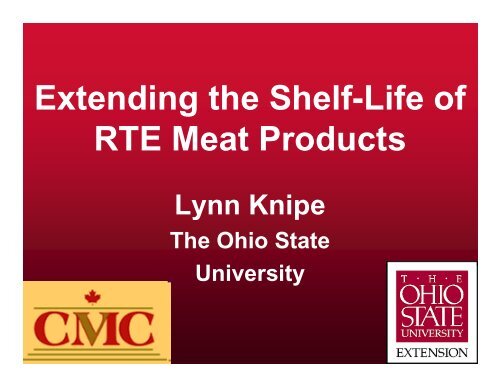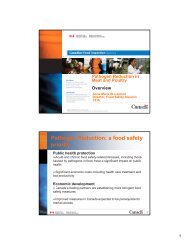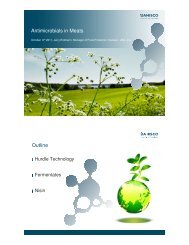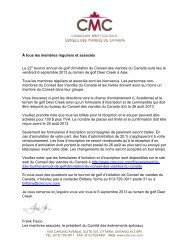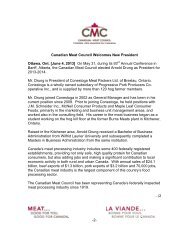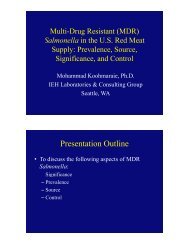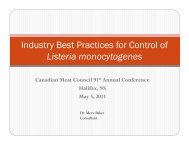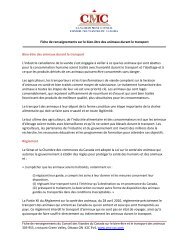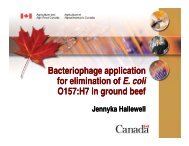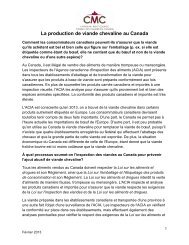Extending the Shelf-Life of RTE Meat Products
Extending the Shelf-Life of RTE Meat Products
Extending the Shelf-Life of RTE Meat Products
Create successful ePaper yourself
Turn your PDF publications into a flip-book with our unique Google optimized e-Paper software.
<strong>Extending</strong> <strong>the</strong> <strong>Shelf</strong>-<strong>Life</strong> <strong>of</strong><br />
<strong>RTE</strong> <strong>Meat</strong> <strong>Products</strong><br />
Lynn Knipe<br />
The Ohio State<br />
University<br />
it
<strong>Shelf</strong> <strong>Life</strong> Extension <strong>of</strong><br />
<strong>RTE</strong> <strong>Meat</strong> <strong>Products</strong><br />
Food Spoilage<br />
•<br />
• oxidation <strong>of</strong> color and flavor<br />
Safety<br />
•<br />
• L. monocytogenes<br />
• C. perfringens
Food Spoilage<br />
• Unsaturated fats<br />
• Oxidation catalyzed by heat, light,<br />
trace metals.<br />
• Color<br />
- metmyoglobin formation<br />
• Flavor<br />
cardboard aroma<br />
–<br />
• Warmed over flavor<br />
• lean meat products
Antioxidants<br />
• Mostly phenolic compounds<br />
• Traditional antioxidants<br />
• BHA, BHT, TBHQ, propyl gallate<br />
Chelating agents<br />
•<br />
• Citric acid, phosphates<br />
• Cleaner label antioxidants<br />
• Spices, fruit extracts<br />
t
Procedures That Delay<br />
<strong>the</strong> Onset <strong>of</strong> Oxidation<br />
Surface browning<br />
•<br />
Sauces &gravies<br />
•<br />
Vacuum tumbling, mixing,<br />
•<br />
stuffing, etc.
Clean Label<br />
Antioxidants<br />
id t<br />
Plums, grape seed extract,<br />
t<br />
• pine bark extract,<br />
rosemary, sage, oregano,<br />
marjoram, thyme, mace,<br />
allspice, cloves, etc.
Plum <strong>Products</strong><br />
Juice, dried - uncured <strong>RTE</strong><br />
•<br />
sausage & roast beef<br />
Dried paste - sausage<br />
•<br />
• Effective in pre-cooked and<br />
p<br />
uncured products.
Grape Seed Extract<br />
• Added at 0.02-0.1%<br />
• No flavor issue<br />
Retards microbial growth <strong>of</strong><br />
•<br />
Listeria, E. coli and<br />
Salmonella.<br />
Darkens meat color<br />
•<br />
Gravinol-Super (Kikkoman)<br />
•
• Oleoresin<br />
Rosemary<br />
• use at 0.02 to 0.10%,<br />
depending upon <strong>the</strong> fat<br />
content <strong>of</strong> <strong>the</strong> product.<br />
• Herbalox, Kalsec Inc.<br />
• Essential oil
O<strong>the</strong>r Spices<br />
Oregano<br />
•<br />
• Water-soluble extract<br />
• Oreganox WS, RAD<br />
Sage<br />
•<br />
Natural Technologies)
Food Safety
Food Safety<br />
Post-Lethality th Treatments<br />
t<br />
•<br />
• effective after post-lethality exposure to<br />
potential ti environmental<br />
contamination<br />
• achieve a minimum <strong>of</strong> 1 log reduction <strong>of</strong><br />
L. monocytogenes<br />
• Listericidal<br />
• Growth Inhibitors<br />
• inhibit growth <strong>of</strong> L. monocytogenes to<br />
not more than 2 logs <strong>of</strong> growth over<br />
<strong>the</strong> duration <strong>of</strong> <strong>the</strong> product’s shelf life<br />
• Listeriostatic
Traditional Processing<br />
• Freezing product – prevents<br />
growth <strong>of</strong> L. mono., must be<br />
kept frozen throughout<br />
distribution<br />
Fermentation<br />
•<br />
• High acid content t (< pH 4.5)
Traditional Processing<br />
Sodium nitrite<br />
•<br />
• contributes tib t to <strong>the</strong> overall<br />
suppression <strong>of</strong> L.<br />
monocytogenes growth<br />
• Product Composition<br />
• higher fat increases Listeria<br />
heat resistance
Antimicrobial Agents<br />
To prevent growth <strong>of</strong> post-cook<br />
• contamination.<br />
at o<br />
Added to product during<br />
• formulation.<br />
Added to finished product<br />
•<br />
before packaging.<br />
• Added to pkg. materials.<br />
• Approved list: USDA Directive<br />
7120.1
Antimicrobial Agents<br />
• Organic Acids<br />
• acetic, citric, i lactic, malic<br />
Salt <strong>of</strong> Organic Acids<br />
•<br />
• lactates, diacetates, citrates,<br />
• Bacteriocins<br />
• Nisin, pediocin<br />
• Clean Label Ingredients
Potential Antimicrobial<br />
Agents<br />
Smoke – liquid id or natural<br />
•<br />
Spices<br />
•
Organic Acids<br />
Reduce <strong>the</strong> pH <strong>of</strong> products<br />
•<br />
Inhibits growth and/or death<br />
•<br />
<strong>of</strong> microorganisms<br />
Dipping or spraying wieners,<br />
•<br />
cooked ham and bologna<br />
slices in acetic acid, lactic<br />
acid, and benzoic acid<br />
solutions was listericidal.<br />
i id l
Organic Acids<br />
• Surface application<br />
reduces need for adding<br />
to formula.<br />
Vacuum packaging<br />
•<br />
distributes over surface.
Salts <strong>of</strong> Organic Acids<br />
48% 4.8% sodium and/or potassium<br />
•<br />
lactate and 0.25% sodium<br />
diacetate approved as<br />
antimicrobial agents in meat<br />
product formulation.<br />
Synergistic effect <strong>of</strong> lactates<br />
• and diacetates in inhibiting<br />
growth (bacteriostatic) <strong>of</strong> L.<br />
monocytogenes in meat<br />
products.
Lactates and Diacetates<br />
Effective when added to<br />
•<br />
product formulations, but<br />
not as a dip.<br />
2-3% sodium lactate without<br />
•<br />
flavor problems.<br />
>0.12% sodium diacetate<br />
•<br />
can result in vinegar flavor.
Uncured <strong>Products</strong><br />
Higher levels <strong>of</strong> sodium<br />
•<br />
lactate addition needed.<br />
Flavorings may need to be<br />
•<br />
added to mildly flavored<br />
products, because <strong>of</strong><br />
lactate flavor at higher<br />
levels.
Purac’s Opti.Form<br />
Listeria i Control Model<br />
Determine amount <strong>of</strong> lactate<br />
•<br />
and ddi diacetate t based upon<br />
level <strong>of</strong> control, and:<br />
Finished product salt and<br />
•<br />
moisture contents
Sodium Lactate<br />
Improves water-holding<br />
•<br />
capacity and cooking<br />
yields.<br />
Enhances beef roast flavor<br />
•<br />
and reduces fading <strong>of</strong> beef<br />
bologna.
Buffered Sodium Citrate<br />
and dS Sodium Diacetate<br />
t<br />
1% Ional-Plus inhibits L.<br />
•<br />
monocytogenes and C.<br />
perfringens fi germination &<br />
outgrowth during chilling<br />
Add dry to product.<br />
•<br />
Use with fresh or cooked<br />
• products.
Bacteriocins<br />
Polypeptides made by<br />
•<br />
bacteria that inhibit o<strong>the</strong>r<br />
bacteria.<br />
Nisin & pediocin are<br />
•<br />
bacteriocidal to L. mono. &<br />
o<strong>the</strong>r Gram +<br />
organisms<br />
Nisin commercially available<br />
•
Nisin<br />
Can be added to formula,<br />
•<br />
applied to surface, coating<br />
to <strong>the</strong> inside <strong>of</strong> sausage<br />
casings, and barrier films.<br />
Less effective in higher fat<br />
•<br />
products.
Lauric Arginate<br />
• Bacteriocidal upon application<br />
Limited bacteristatic effect.<br />
•<br />
Apply as a surface treatment<br />
•<br />
• spray into pouch at packaging.<br />
• dip system<br />
• tumble<br />
Max. use (USDA FSIS) - 200<br />
• ppm (Protect-M, Purac)<br />
• not on label
Octanoic Acid<br />
• Bacteriocidal fatty acid<br />
• processing aid, not labeled (US).<br />
• 400 ppm final product weight.<br />
• Octa-gon (EcoLab)<br />
Sprayed into <strong>RTE</strong> package,<br />
•<br />
prior to vacuum sealing (1-2<br />
logs) and heat shrinking<br />
(activates).<br />
No flavor problems.<br />
•
Cetylpyridinium<br />
Chloride (CPC)<br />
Approved for poultry<br />
•<br />
carcasses (Cecure, Safe<br />
Foods Corp.), not approved<br />
for <strong>RTE</strong> products.<br />
Reduces Listeria<br />
•<br />
monocytogenes on <strong>RTE</strong><br />
products.
Spices<br />
Garlic, sage, & cloves – inhibit<br />
•<br />
L. mono.<br />
o<br />
Gram+ more sensitive to<br />
•<br />
effects <strong>of</strong> spices.<br />
Spice extracts less effective<br />
•<br />
than actual spices.<br />
Essential oils <strong>of</strong> oregano &<br />
• garlic inhibit L. mono. when<br />
added to edible films.
Spices<br />
• Levels <strong>of</strong> spices needed to<br />
prevent L. monocytogenes<br />
in foods high in protein or<br />
fat are higher than would<br />
commonly be used in meat<br />
products.
Smoked <strong>Products</strong><br />
Natural & liquid smoke<br />
• inhibit growth <strong>of</strong> L. mono.<br />
New liquid smoke extract<br />
• (AM-3, without color,<br />
Zesti/Kerry) that t is sprayed<br />
onto <strong>RTE</strong> meat products,<br />
approved as a flavoring.
Clean Label <strong>Products</strong><br />
for Controlling Listeria<br />
i<br />
Cultured sugars<br />
•<br />
• Verdad products (Purac)<br />
• also contains vinegar<br />
• DURAfresh (Kerry Seasonings)<br />
• 0051% 0.05-1% addition level<br />
• Labelled “cultured corn syrup<br />
solids”
Clean Label <strong>Products</strong><br />
for Controlling Listeria<br />
i<br />
Lemon juice & vinegar<br />
•<br />
• Surface application, pickles, or<br />
direct addition<br />
• MOstatin (WTI, Inc.)
Post-Packaging<br />
Packaging<br />
Heat/Pasteurization<br />
t ti<br />
Heat re-applied to package<br />
•<br />
surfaces to destroy any<br />
surface cross contam’n.<br />
Hot water (185ºF/85<br />
F/85ºC, 8 min.)<br />
•<br />
Steam (205ºF/96<br />
F/96ºC, 15 sec)<br />
•<br />
More effective than<br />
•<br />
antimicrobial agents (USDA).
Post-Packaging Packaging Heat<br />
Disadvantages<br />
Difficult to heat all surfaces<br />
•<br />
May adversely affect package.<br />
•<br />
Product changes with heat<br />
•<br />
(color, texture, purge, etc.)<br />
Expensive<br />
•<br />
Apply heat/moisture in ref.<br />
• room (condensation, etc.)
Individually-Wrapped<br />
<strong>Products</strong> are Easiest to Post-<br />
Package Pasteurize/Heat
Cook-in-<strong>the</strong>-Bag Processing<br />
• Listeria contamination is not<br />
likely to occur as long as<br />
package is not opened and<br />
exposed to <strong>the</strong> environment.<br />
• Listeria contamination could<br />
occur at <strong>the</strong> point that final<br />
user opens <strong>the</strong> package.
Lynn Knipe<br />
Processed <strong>Meat</strong>s<br />
Extension Specialist<br />
Ohio State University<br />
(614)292-4877<br />
knipe.1@osu.edu<br />
ed<br />
www.ag.ohio-state.edu/~meatsci/


